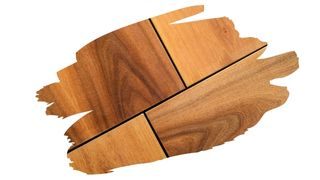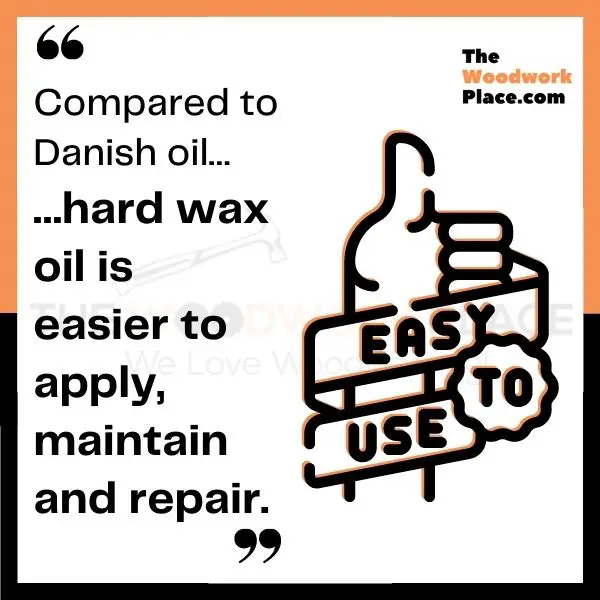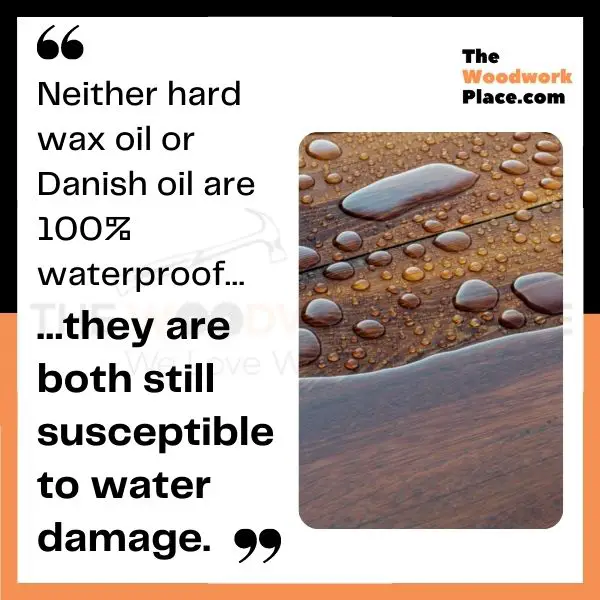They are both oil blended products. But, hard wax oil is as different from Danish oil as chalk and cheese.
Danish oil is undoubtedly one of the most popular wood finishes on the market. And its satin to semi-gloss finish pairs well with open grained hardwood, such as oak.
Related Post: All About Danish Oil: Advantages and Disadvantages
However, a hard wax oil finish will quickly dry into a satin to matte coat that shrugs off wear and tear with ease.
It’s also super simple to apply, upkeep and repair. Plus hard wax oil needs fewer coats, than Danish oil, in order to give wood all-over protection.
So, if time is of the essence, should you swap that can of Danish oil for a container of hard wax oil instead?
Well, in the post below, you will learn what really separates hard wax oils from a Danish oil finish. You will also discover why neither one of these products are 100% waterproof (and why that is a good thing for wood).
And we reveal why pure Tung oil based hard wax oils are better than ones made from natural Linseed oil.

This post may contain affiliate links to products that we receive a commission for (at no additional cost to you). Learn more here.
What Is Hard Wax Oil Used For?
Hard wax oil combines the protection of a penetrating oil, with the wood pore sealing qualities of wood wax. There are many different hard wax oil recipes (you can even make your own homemade version).
But, all hard wax oils are basically a blend of natural oils, (such as Linseed oil and Tung oil), and natural waxes, (such as Beeswax or Carnauba wax).
This mix makes for a wood finish that is better than its separate parts. And it makes for a more durable protection than either oil or wax alone.
Related Post: 7 Surprising Advantages (And 6 Disadvantages) Of Wax Finishes On Wood
Hard wax oil in general, is used as a way to leave a satin protective finish on floors, and wooden furniture. And, unlike say a polyurethane finish, it allows wood grain to keep its natural appearance.
Plus, it doesn’t need anywhere near as many coats as a Danish oil finish. For every 3 coats of Danish oil, you will only need around 2 coats of hard wax oil.

Does Hard Wax Darken Wood?
Generally, a clear hard wax oil won’t darken wood over time. However, when first applied, wood will darken when you apply any type of oil to it (whether it be Danish oil or hard wax oil).
Now, there is a bit of a caveat to this; any oil finish that includes Linseed oil as an ingredient will darken wood.
That is because Linseed oil itself darkens wood. And it can even begin to yellow under UV sunlight.
Related Post: Tru-oil vs Linseed Oil: The Top 5 Things You All Wanted To Know
So, hard wax oil that’s been made using Linseed oil can darken lumber. But, hard wax oil made with a pure Tung oil base ingredient, won’t darken timber surfaces.
What’s more, in high humidity environments, mildew and mold can grow on Linseed oil finishes. That’s not the case with a Tung oil finish.
Which is why a Tung oil based hard wax oil finish is better suited for steam-filled areas like the kitchen or bathroom.
If you want a Tung oiled hard wax product, then check out Liberons Hard Wax Oil. It is made from a special blend of pure premium Tung oil and Carnauba wax. It dries in less than 24 hours, and can even be applied over previously oiled wooden surfaces.
You can find the latest prices for Liberons hard wax oil over on Liberon.com right here.
Isn’t Danish Oil Pretty Much The Same Thing As A Hard Wax Oil?
Well, just like hard wax oil, Danish oil is a blended product made from natural oil ingredients.
Hard wax oil is made from a blend of Linseed oil (or Tung oil) and a natural wax such as Beeswax (or Carnauba wax or sometimes even Candelilla wax).
Danish oil, on the other hand, is made from a blend of Linseed oil (or Tung oil), varnish, and chemical thinners.
The balance of ingredients in either product differs from brand to brand, which means that no two Danish oil (or hard wax oil) products are the same.
But, that’s where the similarities between these two wood finishes end.
Danish oil is a much thinner finish than hard wax oil. And its low viscosity allows it to sink much deeper into wood grain than hard wax oil.
So, acting as a wood preservative, Danish oil does a better job at rejuvenating and enhancing dehydrated furniture.
However, hard wax oil is a penetrating oil wax that does more of its build up on the surface of wood, than underneath. It will sink into wood grain, albeit not as deeply as Danish oil. So, it offers more protection against everyday wear and tear.

Can You Use A Hard Wax Oil Top Coat Over Danish Oil?
Hard wax oils will coat over Danish oil, provided that the Danish oil has first completely cured. And waiting for Danish oil to cure means waiting weeks (not just mere days) for it to harden into a solid resin film.
But, hard wax oils and Danish oil both work best when they can sink into wood. Danish oil sinks in further, sure, but hard wax oils penetrate lumber too.
If you put a hard wax oil coat over a cured Danish oil, the hard wax oil won’t be able to get into the natural wood underneath.
In short; just because you can apply it, doesn’t mean you should. Hard wax oil works best when applied directly onto bare wood. And a Danish oil primer coat will prevent hard wax from doing its best work.
Related Post: Don’t Put Hard Wax Oil Over Wood Stain (Do This Instead…)
Is Hard Wax Oil Waterproof?
A 100% waterproof finish is one that 100% blocks liquid, droplets and even water vapor from getting into wood.
While a microporous finish is one that prevents liquid and droplets from getting into wood. However, it doesn’t prevent water vapor from getting through.
So, as a microporous finish, hard wax oil is not waterproof. Still, it is water resistant and stain resistant.
What Does Microporous Mean? And Why Does It Matter For Wooden Surfaces?
Wood, even after it has been seasoned, still has a bit of moisture in it.
When lumber is first cut, it is classed as ‘Green Wood’ with a moisture content of 100%.
After you kiln-dry wood, it’s moisture content falls drastically. But even kiln-dried wood has around an 18% moisture content.
Related Post: How To Dry Pressure Treated Wood (Quickly And Without Warping)
That moisture content gets released over time as water vapor. And, (especially during warm weather), it escapes through wood pores. A microporous wood finish lets all of that water vapor escape.
In other words, microporous wood finishes let wood ‘breathe’ out water vapor. Otherwise, all of that woodsy moisture could build up. And that can cause finish adhesion problems later on.
Now, while microporous finishes allow moisture vapor out, they also allow moisture vapor in too (especially in very humid climates). Which means that even though microporous finishes are water resistant, they’re never quite fully waterproof.
That’s why hard wax oil finishes and Danish oil finishes are both still susceptible to water ring damage.
Related Post: Will Polyurethane Prevent Water Rings? (Best Practice Revealed)
To Wrap Up, Here Are The 3 Key Takeaways…
- 1). Compared to Danish oil, hard wax oil is easier to apply, maintain and repair.
- 2). Use hard wax oil products that have pure Tung oil as their natural oil base ingredient.
- 3). Neither hard wax oil or Danish oil are 100% waterproof. They are both still susceptible to water damage.



